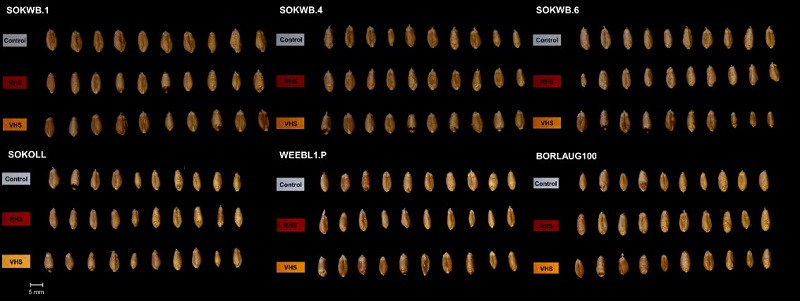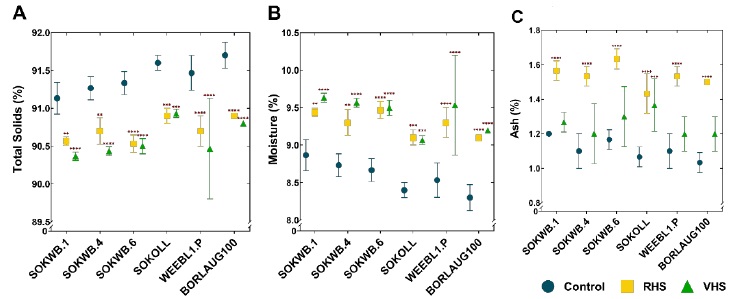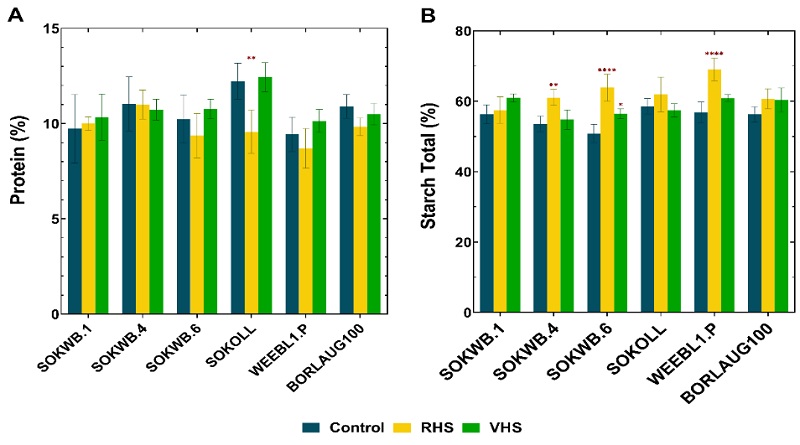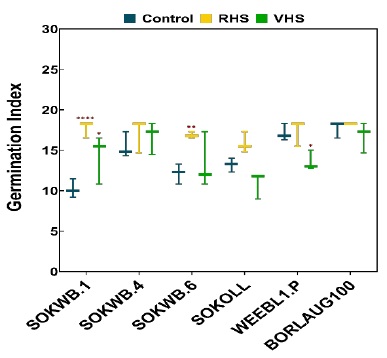Introduction
Wheat is the third most important cereal worldwide due to its use for human and animal feeding and variety in food preparation. Sonora is the leading wheat-producing state in México; however, the drastic change in climatic conditions puts crops and especially wheat production at risk [1]. Climate change decreases wheat yield in northwestern Mexico. Hernández-Ochoa et al. [1] simulated the effects of climate change on wheat yield in Mexico to the year 2050 and determined a decrease of 6.2 % for each degree that the temperature rises during the winter in the wheat planting season in northwestern Mexico. Therefore, the search and introduction of crops tolerant to heat stress cannot be delayed any more.
Wheat is the base product to produce flours used for many human foods. Consequently, it is necessary to maintain quality standards in the grains and to ensure annual production to meet industrial demands. Heat stress-susceptible stages of the development of wheat are the reproductive stage and grain filling [2]. Heat during these stages influences the quality of the grain. [2]. During the flowering stage, temperatures above 20 °C accelerate grain development, reducing grain number and grain maturation [3]. Grain filling is the final stage of the development of wheat plants; heat stress reduces the period of grain filling, decreases the weight of the grain, and shortens the developmental and maturation periods in the grains [3].
The germination of wheat seeds mainly requires nutrients, water (30-50 % seed mass), and favourable temperatures (< 20 °C) [4]. In addition, temperature directly affects the enzymes that regulate the chemical reactions inside the seed after imbibition, influencing the metabolic processes of respiration, nutrient transport, and embryo growth [4]. Therefore, the germination index (GI), which measures the percentage and rate of germination, considers all these internal and external factors [5,6].
The quality of wheat grains is directly related to the composition of protein and starch. Proteins make up 10 to 20 % of the total weight of the grain, whereas starch is the most abundant reserve nutrient in wheat seeds, making up to 70 % of the grain weight. Exposure to heat stress accelerates gluten synthesis, resulting in a higher proportion of protein in a shorter time after anthesis, leading to low-yielding and/or poor-quality grain filling [7].
Starch is found mainly in the endosperm and comprises amylose (20-30 %) and amylopectin (70-80 %). Under heat stress conditions, amylopectin synthesis is reduced and thus, total starch content decreases [8]. That reduction is due to the sensitivity of starch-synthesizing enzymes to temperatures higher than 35°C [8]. In addition, heat stress alters the morphology of starch granules and the number of cells in the endosperm, where nutrients are deposited in wheat grains, decreasing their size and viability [8,9]. Wheat genotypes capable of maintaining starch accumulation have larger tolerance to high-temperature stress [10].
The hardness of the grain is the result of the combination of the protein and starch in the endosperm. This parameter influences flour milling time and water absorption capacity. The grains protein content defines the flour quality and baking. Round and small grains are more tolerant to protein source limitations during grain-filling [11].
This work aimed to evaluate the chemical composition of the flour obtained from grains of different wheat genotypes subjected to heat stress during the vegetative and reproductive stages and the influence of this heat stress on the germination index. These studies contribute to the knowledge of the changes caused by heat stress on wheat genotypes.
Experimental
Biological Material
Grains of six wheat genotypes (SOKOLL, WEEBL1.P, SOKWB.1, SOKWB.4, SOKWB.6, and BORLAUG100) were used in this study, their pedigree is shown in Table 1. The genotypes were cultivated in 3.2 m2 plots at the National Institute for Forestry, Agriculture, and Livestock Research (INIFAP) in the Yaqui Valley, Sonora. The planting dates were December 2020 (control), January 2021 (heat stress during the reproductive stage), and October 2021 (heat stress during the vegetative stage). The genotypes were sown according to a completely randomized block design, with four replicates each.
Table 1 Wheat genotypes used in the experimental.
| Name | Pedigree | CID | SID | GID |
| SOKOLL | SOKOLL | 334948 | 266 | 3825355 |
| WEEBL1.P | WEEBILL1 | 260140 | 83 | 2448314 |
| SOKWB.1 | SOKOLL/WBLL1 | 460354 | 127 | 6056138 |
| SOKWB.4 | SOKOLL/WBLL1 | 460354 | 132 | 6056143 |
| SOKWB.6 | SOKOLL/WBLL1 | 460354 | 548 | 6676763 |
| BORLAUG100 | ROELF07/4/BOW/NKT//CBRD/5/ FRET2/TUKUTU//FRET2 | na | na | na |
Wheat Flour Preparation
Whole grains (40 g of each genotype and each sowing date) were ground using an IKA M20 (USA) miller, and the flours were passed through a US 40 sieve.
Chemical Proximate Analysis
The crude protein of wheat grains from each genotype was measured by micro-Kjeldahl (N × 5.7) according to the AACC method [12], and Moisture and ashes following the AOAC methods [13,14]. All the measurements were done in triplicates.
Starch Determination
The starch content was determined using the commercial kit from Megazyme, assays K-TSTA (Ireland International, Ltd., Bray, Ireland) according to the manufacturer procedure [15,16].
Germination Index
The seeds used for germination experiments were randomly selected. The seeds were sterilized by rinsing with 0.05 % Tween 20 for 30 min, followed by four wash with sterile distilled water. Later the seeds were rinsed with 10 % plant preservative mixture (PPM) for 20 min, followed by three washes with sterile distilled water. The seeds were germinated on filter paper in Petri dishes containing sterile distilled water for 72 h at 22 °C. Three replicates per group were used with ten seeds per replicate. The germination index (GI) was determined as ((nt/dt), where nt represents the number of germinated seeds on the t day, and dt represents germination days [17].
Statistical Analysis
A two-way ANOVA (p < 0.05) was applied using GraphPad Prism 8 software, followed by Dunnett’s multiple comparisons tests (95 % confidence level). In figures and tables, different symbols express significantly different results between control and heat treatments for the same genotype (*, **, ***, ****).
Results and discussion
Seeds analysis
Seeds produced by the plants grown under optimal temperature (control) or under heat stress conditions were used to analyze their morphology and germination index changes. The seeds that came from plants subjected to heat stress during the reproductive stage (RHS) or during the vegetative stage (VHS) showed changes in their morphology. The RHS seeds were longer and thinner than those of the control group (Fig. 1). In addition, they showed a rougher texture on the pericarp surface.

Fig. 1 Effect of heat stress on wheat seed morphology. Seeds from plants grown under optimal temperature conditions (control group); seeds from plants subjected to heat stress during the reproductive stage (RHS) and vegetative stage (VHS).
The VHS seeds were more rounded than the control group (Fig. 1). Furthermore, their colouration was darker, and some seeds had a black spot in the base (e.g., genotype SOKWB.4). Similar results were reported in rice, where moderate heat stress (35 °C) during early seed development significantly reduces the final size in mature seeds and showed a black spot at the tip [18].
In order to analyze the heat stress impact on the weight of the grains from RHS and VHS, the thousand-grain weight (TGW) trait was obtained. Results for RHS showed a significant decrease in TGW in all genotypes, except for BOURLAUG100 (Table 2). This decrease varied from 14 to 25%, SOKWB.4 was the genotype that showed the greatest decrease in TGW.
Table 2 Thousand-grain weight of the progeny of six genotypes planted on three sowing dates.
| THOUSAND-GRAIN WEIGHT (g) | |||
| Control | RHS | VHS | |
| SOKWB.1 | 56.3 ± 2.9 | 48.1 ± 3.8*** | 64.0 ± 1.7*** |
| SOKWB.4 | 54.4 ± 0.3 | 40.7 ± 4.5**** | 62.8 ± 1.8*** |
| SOKWB.6 | 55.5 ± 2.6 | 43.2 ± 2.0**** | 59.2 ± 2.8ns |
| SOKOLL | 49.4 ± 2.4 | 42.7 ± 1.5** | 50.4 ± 1.6ns |
| WEEBL1.P | 47.3 ± 1.9 | 39.8 ± 2.7** | 53.2 ± 2.6* |
| BORLAUG100 | 46.2 ± 3.1 | 48.8 ± 2.0ns | 54.1 ± 1.6*** |
Optimal conditions (control group). Grains product of heat stress in the reproductive stage (RHS) and heat stress in the vegetative stage (VHS). Significance (*) p<0.05; (**) p<0.01; (***) p<0.001; (****) p< 0.0001; (ns) no significance.
The opposite occurred in the VHS progeny, where the TGW increased significantly from 12 to 17% in four of the six genotypes, while the wheat genotypes SOKWB.6 and SOKOLL maintained the TGW. TGW increments indicate that during the grain-filling stage, the number of grains produced was lower, but they reached a weight similar to the weight of the grains of plants that were not under stress. Differences between TGW results regarding the wheat plants development stage are related to the strong effect that has the heat stress on photosynthesis as found by Matsunaga et al. [19]. These authors found that heat stress during the reproductive stage decreases the rate of photosynthetic electron transport and triose phosphate utilization [19]. Therefore, the decrease in TGW in seeds from plants under RHS can be ascribed to the grain filling being diminished in wheat plants due to a decrease in the synthesis and/or export of sucrose.
On the other hand, the increase in the TGW of the VHS progeny pointed to that fewer grains are required to meet industrial demands. However, this is not an indication that the flour has the quality standards required for food processing. It is known that heat stress affects the grain quality of many cereals and legumes due to the limitation of assimilates and the lower remobilization of nutrients [20], therefore, the quality of the flour from each genotype was analyzed.
Grain’s chemical composition
Flour from grains of the RHS and VHS plants significantly decreased the percentage of total solids (TS) in all genotypes compared to the flour from grains of the control group (Fig. 2(A)). On the contrary, in all genotypes, the moisture percentage (M) significantly increased in the flour from VHS and RHS grains (Fig. 2(B)), while the ash percentage increased only during RHS in all genotypes (Fig. 2(C)).
Our results show that heat stress in the reproductive stage has an impact on ash content (Fig. 2). It is interesting that we found an increase in the ash content in the flour of seeds from RHS as in other studies with different wheat genotypes, a decrease in the ash content was found in grains from plants exposed to heat stress during the reproductive stage [21]. However, ash may influence the germination of wheat genotypes studied in this work, germination because it contains magnesium, phosphorus, and calcium, important nutrients for plant germination and development.
Starch and protein are the two main nutrients of the grain, which represent 70 and 20 % respectively of the total weight of the grain [22]. Heat stress hardly affects the grain protein concentration in wheat; however, elevated CO2 concentration can increase the total amount of protein in the grain, but reduce its concentration [20,23].

Fig. 2 Heat stress effect on total solids, moisture, and ash in the flour from wheat genotypes. Optimal conditions (control group). Grains product of heat stress in the reproductive stage (RHS) and heat stress in the vegetative stage (VHS). Significance (**) p<0.01; (***) p< 0.001; (****) p< 0.0001.
In the present study, the protein content of RHS progeny decreased significantly in the SOKOLL genotype (2.6 %); whereas SOKWB.6, WEEBIL1.P and BORLAUG100 showed a tendency to diminish (0.9 %, 0.8 %, 1.1 %, respectively) in contrast to the control group (Fig. 3(A)). In the VHS progeny, the protein content did not show significant differences between stressed and control seeds. In wheat, heat stress reduces N remobilization [24], which could explain the decrease in the protein content in the RHS progeny (Fig 3A).

Fig. 3 Changes in protein and starch total in the flour of wheat genotypes under heat stress. Optimal conditions (control group). Grains product of heat stress in the reproductive stage (RHS) and heat stress in the vegetative stage (VHS). Significance (*) p<0.05; (**) p<0.01; (****) p< 0.0001.
Heat stress significantly limits starch biosynthesis in wheat grains but induces an increase in total soluble sugar and protein [25, 26]. Likewise, high temperatures in the period before anthesis increase the translocation of carbohydrates from the stem to the grain, which results in a smaller reduction of the starch content in the grains [27]. The starch total content (ST) was significantly increased in the SOKWB.4 (8 %), SOKOWB.6 (13 %), and WEEBL1.P (12 %) genotypes in the RHS progeny (Fig. 3(B)), while in the VHS progeny, although the ST content tended to increase, it was only significant in SOKWB.6 genotype, increasing by 6 % (Fig. 3(B)).
Our results are in concordance with other studies where a significant increase in ST in grains was produced by plants exposed to thermal shock above 30 °C, in addition to a limited accumulation of dry matter in the wheat grain [28]. Total sugars content tends to increase in wheat grains from plants exposed to heat stress, but the proportion of each sugar (stachyose, sucrose, fructose, raffinose, glucose, mannitol) varies in each genotype [21].
Heat stress during grain development in cereals can have a substantial influence on grain size and nutrient uptake [29], which can be later decisive for the germination ability of the seeds and the viability of the seedlings [30]. The germination index (GI) is an indicator of the interaction among the factors that promote or inhibit germination, in addition to the others that favour or prevent radicle growth [31]. Therefore, the GI was evaluated in the seeds from each genotype from RHS and VHS.
Germination index
The results showed that GI increased by 7.5 % in seeds from SOKWB.1 and 4.7 % in SOKWB.6 genotypes from plants subjected to RHS compared to the control group (Fig. 4). The other genotypes exhibited no significant differences in GI compared to that of the control (Fig. 4). Similarly, in the VHS progeny the GI increased significantly (4.1 %) in the SOKWB.1 genotype seeds and it decreased by 3.6 % (significantly) in the WEEBL1.P genotype seeds (Fig. 4).

Fig. 4 Changes in the germination index of six genotypes in three sowing dates. Seeds progeny of optimal conditions (control group); of heat stress in the reproductive stage (RHS) and of heat stress in the vegetative stage (VHS). Significance (*) p<0.05; (**) p<0.01; (****) p< 0.0001.
The RHS seed progeny showed a longer shape with a reduction in TGW (except for genotype BOLAUG100) and presented a GI higher or with a tendency to increase compared to the control group (Fig. 1 and 4, Table 2). On the other hand, while the VHS progeny seeds presented small and round seeds, TGW was higher than that of the control and higher than the RHS progeny seeds, and higher or lower GI compared to the control, depending on the genotype (Fig. 1 and 4, Table 2). From this, it could be inferred that there is a relationship between the morphology of the seeds and the elements required for germination.
Conclusion
The present work was undertaken to evaluate the grains’ chemical composition of six wheat genotypes subjected to heat stress during the vegetative and reproductive stages and to relate it to its germination index, which often occurs in the natural environment. The morphological changes observed in the seeds in all the seed progeny of heat stress (RHS and VHS) correlate to changes in the thousand-grain weight of both progenies. GI in RHS seeds was associated to the starch total content and a tendency to decrease the total protein, although starch or protein content is not associated with GI in the VHS progeny seeds. GI in seeds from plants under VHS must be mainly regulated by changes in the levels of phytoregulators, such as gibberellic acid and abscisic acid. It is necessary to carry out more studies to explain the changes in GI shown by seeds from plants under VHS.











 nueva página del texto (beta)
nueva página del texto (beta)


